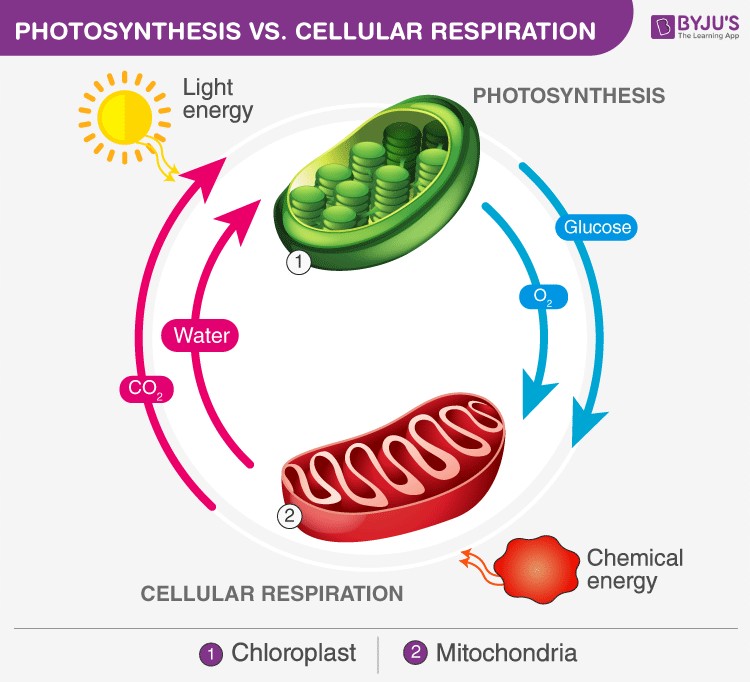Plants release oxygen, a byproduct of photosynthesis, which we inhale to fuel cellular respiration and generate ATP. Both cellular respiration and photosynthesis are fundamental biological processes, intricately linked and essential for life as we know it. While they are distinct processes, they are also complementary, forming a cycle that sustains ecosystems. Respiration utilizes oxygen and glucose to produce water and carbon dioxide, whereas photosynthesis uses carbon dioxide and water to synthesize glucose and release oxygen. This article will delve into a detailed comparison of cellular respiration and photosynthesis, highlighting their key differences and interconnectedness.
Understanding Cellular Respiration
Cellular respiration is a catabolic process that occurs in all living organisms, from the simplest bacteria to the most complex animals. It’s the mechanism by which cells break down glucose (a sugar molecule) and other organic molecules in the presence of oxygen to release energy in the form of ATP (adenosine triphosphate), the cell’s energy currency. This process primarily takes place in the mitochondria, often referred to as the “powerhouses of the cell.” In essence, cellular respiration is how organisms extract the energy stored in food to power their life functions.
Decoding Photosynthesis
Photosynthesis, on the other hand, is an anabolic process exclusive to phototrophs – organisms like green plants, algae, and some bacteria. It’s the remarkable process of converting light energy into chemical energy in the form of glucose. Photosynthesis occurs within chloroplasts, organelles within plant cells containing chlorophyll, the pigment that captures sunlight. Using sunlight, carbon dioxide from the atmosphere, and water, plants synthesize glucose and release oxygen as a byproduct. Photosynthesis is the foundation of most food chains, as it’s how energy from the sun is initially captured and made available to living organisms.
Key Differences Between Cellular Respiration and Photosynthesis
While both processes are crucial for life, they exhibit significant differences. The table below summarizes these key distinctions:
 Comparing Photosynthesis and Cellular Respiration: A visual representation highlighting the key differences and complementary nature of these essential biological processes, including inputs and outputs like carbon dioxide, oxygen, glucose, water, and energy.
Comparing Photosynthesis and Cellular Respiration: A visual representation highlighting the key differences and complementary nature of these essential biological processes, including inputs and outputs like carbon dioxide, oxygen, glucose, water, and energy.
| Feature | Cellular Respiration | Photosynthesis |
|---|---|---|
| Occurrence | All living organisms | Phototrophs (plants, algae, some bacteria) |
| Location | Mitochondria | Chloroplasts |
| Reactants | Glucose and Oxygen | Carbon Dioxide, Water, and Light Energy |
| Products | Carbon Dioxide, Water, and ATP (Energy) | Glucose, Oxygen, and Water |
| Process Type | Catabolic (breaks down molecules) | Anabolic (builds molecules) |
| Gas Exchange | Oxygen in, Carbon Dioxide out | Carbon Dioxide in, Oxygen out |
| Energy Role | Releases energy from food | Captures and stores energy in food |
| Energy Reaction Type | Exergonic (releases energy) | Endothermic (requires energy) |
| Light Requirement | Not required; occurs constantly | Required; occurs in the presence of sunlight |
| Chemical Equation | C6H12O6 + 6O2 → 6CO2 + 6H2O | 6CO2 + 6H2O → C6H12O6 + 6O2 |
The Interconnected Dance of Life: Respiration and Photosynthesis
Cellular respiration and photosynthesis are not isolated processes; they are intrinsically linked in a beautiful cycle. The oxygen produced during photosynthesis is essential for cellular respiration in most organisms, including plants themselves (for respiration at night or in non-photosynthetic parts). Conversely, the carbon dioxide released during cellular respiration is a vital reactant for photosynthesis. This interdependence highlights the balanced and cyclical nature of life on Earth. Photosynthesis creates the glucose that respiration breaks down, and respiration generates the carbon dioxide that photosynthesis utilizes. This cycle ensures a continuous flow of energy and matter through ecosystems, sustaining life as we know it.
Conclusion
In summary, cellular respiration and photosynthesis, while distinct in their mechanisms and purposes, are fundamentally complementary processes. Photosynthesis harnesses light energy to produce glucose and oxygen, while cellular respiration utilizes glucose and oxygen to release energy for cellular work, producing carbon dioxide and water as byproducts. Understanding both processes and their interconnectedness is crucial for comprehending the basic principles of biology and the delicate balance of life on our planet.

